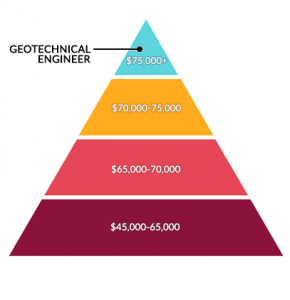The 25-Second Trick For Geotheta
The 25-Second Trick For Geotheta
Blog Article
How Geotheta can Save You Time, Stress, and Money.
Table of ContentsThe Best Strategy To Use For GeothetaLittle Known Facts About Geotheta.The 10-Second Trick For GeothetaExcitement About GeothetaThe smart Trick of Geotheta That Nobody is Discussing

They carry out website investigations, accumulate samples, perform laboratory tests, and evaluate data to examine the suitability of the ground for construction jobs - Geo Tech Engineering. Based upon their findings, geotechnical designers give recommendations for foundation style, incline stability, maintaining frameworks, and mitigation of geotechnical dangers. They team up with other specialists, such as engineers, structural engineers, and construction teams, to guarantee that geotechnical considerations are integrated right into the total job style and application
By evaluating the behavior and residential properties of soil and rock, they can identify potential geotechnical risks such as landslides, soil settlement, or slope instability. Their experience aids protect against failings or mishaps that might endanger lives and residential property. Right here are some thorough tasks and obligations of a geotechnical engineer: Website Investigation: Geotechnical engineers conduct website examinations to collect data on subsurface conditions.
They analyze the information to understand the homes and habits of the dirt and rock, including their toughness, leaks in the structure, compaction qualities, and groundwater conditions. Geotechnical Analysis and Layout: Geotechnical engineers evaluate the data gathered during site investigations to evaluate the stability and suitability of the website for building and construction tasks. They perform geotechnical estimations and modeling to examine aspects such as bearing capacity, negotiation, incline security, lateral planet pressures, and groundwater flow.
Some Known Questions About Geotheta.
Structure Design: Geotechnical designers play an important role in creating structures that can securely support the intended framework. They analyze the soil problems and load needs to figure out the proper structure type, such as superficial foundations (e.g., footings), deep foundations (e.g (https://www.imdb.com/user/ur185987626/?ref_=nv_usr_prof_2)., heaps), or specialized strategies like soil improvement. They take into consideration elements such as settlement limits, birthing capability, and soil-structure interaction to develop optimum structure styles
They evaluate construction strategies, display site activities, and perform area evaluations to verify that the layout referrals are followed. If unpredicted geotechnical problems occur, they examine the scenario and give recommendations for removal or modifications to the design. Threat Evaluation and Reduction: Geotechnical designers evaluate geotechnical threats and risks connected with the task site, such as landslides, liquefaction, or dirt erosion.

Cooperation and Communication: Geotechnical engineers function closely with various other specialists entailed in a task, such as designers, structural designers, and building groups. Effective interaction and collaboration are necessary to incorporate geotechnical considerations right into the total project design and building procedure. Geotechnical designers supply technological competence, solution queries, and make certain that geotechnical needs are met.
Getting My Geotheta To Work
Below are some kinds of geotechnical designers: Foundation Designer: Foundation designers focus on designing and examining structures for frameworks. They examine the dirt problems, lots demands, and site features to determine one of the most appropriate foundation type and style, such as superficial foundations, deep foundations, or specialized methods like stack foundations.
They review the factors affecting incline security, such as dirt residential properties, groundwater problems, and slope geometry, and develop approaches to avoid slope failings and reduce dangers. Quake Designer: Quake engineers concentrate on evaluating and designing frameworks to endure seismic pressures. They evaluate the seismic hazard of a site, evaluate dirt liquefaction possibility, and establish seismic style criteria to guarantee the safety and durability of structures throughout earthquakes.
They perform area testing, gather samples, and examine the gathered information to characterize the soil buildings, geologic developments, and groundwater problems at a site. Geotechnical Instrumentation Engineer: Geotechnical instrumentation engineers concentrate on tracking and gauging the habits of soil, rock, and frameworks. They set up and keep instrumentation systems that keep track of elements such as dirt negotiation, groundwater levels, incline movements, and structural variations to assess performance and supply early warnings of possible problems.
Geotheta Can Be Fun For Anyone
They perform examinations such as triaxial tests, loan consolidation tests, straight shear tests, and leaks in the structure tests to gather information for geotechnical evaluation and style. Geosynthetics Designer: Geosynthetics engineers focus on the design and application of geosynthetic products, such as geotextiles, geogrids, and geomembranes. They utilize these materials to improve soil security, enhance slopes, offer water drainage remedies, and control disintegration.
They tend to be investigatory people, which indicates they're intellectual, introspective, and investigative. They are curious, methodical, rational, logical, and logical. Some of them are likewise social, suggesting they're kind, charitable, participating, client, caring, helpful, empathetic, tactful, and pleasant - Consulting Engineers.
In the workplace setting, geotechnical designers use specialized software tools to carry out estimations, produce styles, and evaluate data. They prepare records, next review task specifications, connect with clients and staff member, and coordinate job tasks. The workplace setup provides a helpful environment for research, evaluation, and partnership with other specialists involved in the job.
Fascination About Geotheta
They frequently check out job sites to perform site examinations, examine geotechnical conditions, and gather data for evaluation. These gos to include traveling to different locations, occasionally in remote or difficult terrains. Geotechnical engineers might perform soil sampling, conduct examinations, and screen building activities to ensure that the geotechnical aspects of the task are being implemented properly.
Geotechnical designers likewise operate in specialized geotechnical laboratories. In these facilities, they conduct experiments, execute examinations on soil and rock examples, and analyze the design residential properties of the products. Geotechnical lab designers work extensively in these settings, managing screening devices, running tools, and tape-recording data. They work together with various other research laboratory personnel to make certain exact and dependable testing outcomes.
Report this page